Which cloche should I choose?

Buying a cloche should be considered a garden investment for the future, so it's important to buy the right one for you. Ventilation is the key to success when covering plants because still, damp air will encourage fungal diseases like damping off and botrytis. So make time to either uncover your seedlings or young plants every day, exposing them to fresh air, or buy a cloche with a built-in ventilator like the 'Ventilated Glass Cloche'. For slightly hardier plants, you can opt for something with open sides - like our 'Lily Cloches'. They form a tent shape over the plants so are perfect for protecting rows of seedlings. They come in two lengths, the shorter one measures 40cm and the longer is 59.5cm in length. Both are heavy enough to stay in place should your garden be exposed and windy. Water the plants regularly though because rain will not penetrate most cloches - this includes enviromesh and horticultural fleece.
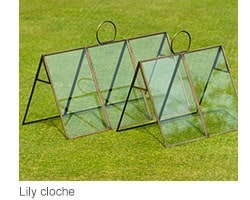
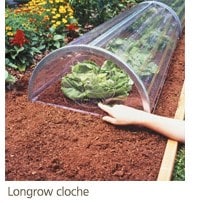

The 'Longrow Cloche' measures 1.2m and its generous proportions allow you to use this with dwarf beans, strawberries, melons, salad and all root crops. The circular end panels turn at a touch for adjustable ventilation and it has a rugged steel frame, so it too will stay put even in windy gardens. The corrugated PVC is tough enough to cope with all sorts of weather and it can be stored from year to year.
The 1m long 'Kitchen Garden Cloche' is more stylish, yet very sturdy. The high quality U.V. resistant clear plastic is held in galvanised black powder coated steel. It has adjustable air vents and galvanised steel ground pegs for securing to the ground, plus a handy handle. Plastic cloches are usually much lighter and they do need pegging down to prevent them blowing away in rough weather.
Highly decorative as well as practical
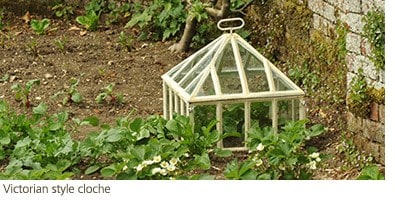
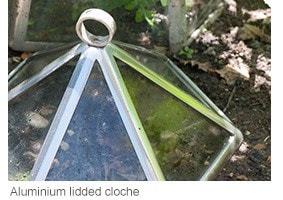 Cloching is an ancient art and the Romans were known to protect their cucumbers with glass covers. However it was the French who perfected the art of raising crops under glass. They used giant glass bell jars, which they called cloches. These were originally blown by Italian glassmakers in the late 16th century and reached the south of France a little later. Olivier de Serres (literally Oliver of the Greenhouses) used them to raise melons by 1600. The big glass hats became known as cloches in France, but they were expensive to produce and highly breakable. By 1677 square cloches with pieces of glass set in lead were being made in England. Often old window panes were used in their construction and, if a piece of glass broke it could be replaced. Both were highly decorative. They were propped up on wood during the day, or moved to one side and then replaced for the night. That method helped to harden off the crop.
Cloching is an ancient art and the Romans were known to protect their cucumbers with glass covers. However it was the French who perfected the art of raising crops under glass. They used giant glass bell jars, which they called cloches. These were originally blown by Italian glassmakers in the late 16th century and reached the south of France a little later. Olivier de Serres (literally Oliver of the Greenhouses) used them to raise melons by 1600. The big glass hats became known as cloches in France, but they were expensive to produce and highly breakable. By 1677 square cloches with pieces of glass set in lead were being made in England. Often old window panes were used in their construction and, if a piece of glass broke it could be replaced. Both were highly decorative. They were propped up on wood during the day, or moved to one side and then replaced for the night. That method helped to harden off the crop.
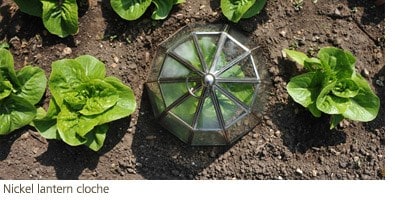
Modern reproductions add great style to productive kitchen gardens, potagers and wildflower areas, as well as giving protection to tender crops and plants. The rugged, square 'Victorian Style Cloche' can be left out all year and their cream paintwork and slightly rusty patina mixes well with vegetables and annuals, making a real feature to focus the eye. We have designed our own glass and aluminium version, the 'Aluminium Lidded Cloche', which offers a modern twist with (at 50cm diameter) generous proportions. More from our own range are the 'Lantern' reproduction cloches. They come in nickel and bronzed metal, both in two sizes. These handsome cloches could be used with ferns as well as productive crops. There are also rounder 'Bell Cloches' in heavy glass, the larger ones being the most useful and decorative outside, whilst the smaller ones are also useful indoors and out. Whatever you choose, cloches are a great way to extend the growing season. Your young or frost-tender plants will be be kept cosy and warm, while these stylish creations will look effortlessly stylish
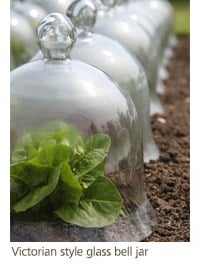
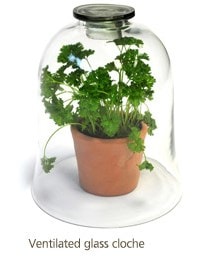








 Cloching is an ancient art and the Romans were known to protect their cucumbers with glass covers. However it was the French who perfected the art of raising crops under glass. They used giant glass bell jars, which they called cloches. These were originally blown by Italian glassmakers in the late 16th century and reached the south of France a little later. Olivier de Serres (literally Oliver of the Greenhouses) used them to raise melons by 1600. The big glass hats became known as cloches in France, but they were expensive to produce and highly breakable. By 1677 square cloches with pieces of glass set in lead were being made in England. Often old window panes were used in their construction and, if a piece of glass broke it could be replaced. Both were highly decorative. They were propped up on wood during the day, or moved to one side and then replaced for the night. That method helped to harden off the crop.
Cloching is an ancient art and the Romans were known to protect their cucumbers with glass covers. However it was the French who perfected the art of raising crops under glass. They used giant glass bell jars, which they called cloches. These were originally blown by Italian glassmakers in the late 16th century and reached the south of France a little later. Olivier de Serres (literally Oliver of the Greenhouses) used them to raise melons by 1600. The big glass hats became known as cloches in France, but they were expensive to produce and highly breakable. By 1677 square cloches with pieces of glass set in lead were being made in England. Often old window panes were used in their construction and, if a piece of glass broke it could be replaced. Both were highly decorative. They were propped up on wood during the day, or moved to one side and then replaced for the night. That method helped to harden off the crop.


